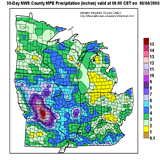Published 5 Aug 2008
URL: http://www.kingcorn.org/news/articles.08/Toadstranglers-0805.html
Toadstranglers in August: Good or Bad for the Corn Crop?
R.L. (Bob) Nielsen
Agronomy Dept., Purdue Univ.
West Lafayette, IN 47907-2054
Email address: rnielsen
at purdue.edu
![]() olks
often joke that the Chicago Board of Trade reacts to whatever the weather
is doing in downtown Chicago. Well, this Extension corn specialist freely
admits that the torrential rainfall occurring outside the windows of Lilly
Hall this morning has caught his attention. What are the consequences of excessive
rainfall now that much of the state's corn crop is moving into the grain filling
period? As you might expect, the answer is "it depends".
olks
often joke that the Chicago Board of Trade reacts to whatever the weather
is doing in downtown Chicago. Well, this Extension corn specialist freely
admits that the torrential rainfall occurring outside the windows of Lilly
Hall this morning has caught his attention. What are the consequences of excessive
rainfall now that much of the state's corn crop is moving into the grain filling
period? As you might expect, the answer is "it depends".
Obviously, torrential rain plus strong winds often result in stalk breakage (aka “green snap”) or root lodging (plants uprooted and laying nearly flat to the ground). The yield effect of “green snap” damage depends on the percentage of field affected and whether the stalk breakage occurs above or below the ear, but is usually serious regardless. Obviously, stalk breakage below the ear results in zero yield for that plant. Stalk breakage above the ear results in significant yield loss due to the loss of upper canopy photosynthesis capacity for that plant.
Root lodged corn will recover or straighten up to varying degrees depending on the growth stage of the crop. Generally, younger corn has a greater ability to straighten up with minimal “goose-necking” than older corn. Root lodged corn that is beyond the silking stage of development will likely not straighten back up. Yield effects of root lodging depend on whether soil moisture remains adequate for root regeneration, the severity of root damage due to the uprooting nature of root lodging, and the degree of “goose-necking” that develops and its effect on the harvestability of the crop.
Outright flooding of low-lying fields along rivers or creeks this late in the season can cause several problems for a corn crop. Deposits of sediment and crop residues often remain on crop plants once the water recedes that either outright smother any surviving plants or greatly reduce their ability to capture sunlight and photosynthesize carbohydrates until subsequent rain washes it off the plants. Mud and crud that cakes the leaves and stalks encourage subsequent development of fungal and bacterial diseases in damaged plant tissue. Further physical crop damage (soil erosion, washing away of plants, lodging of plants, and plant tissue damage) occurs from the force of the flowing water on land adjacent to flooded creeks and rivers as well as from any debris caught up in the floodwaters.
Soil oxygen is quickly depleted in ponded areas of fields or areas that are simply poor drained and remained saturated for days after a serious rain event. With typical summer temperatures, such oxygen deprivation quickly takes its toll on the root system of a full-size corn crop. Damage to a corn plant's root system today will predispose the crop to the development of root and stalk rots later by virtue of the photosynthetic stress imposed by the limited root system during the important grain filling period. Growers should monitor affected fields later in August or early September for the possible development of stalk rots and modify harvest-timing strategies accordingly.
Click on image to open a larger version. To close popup window, click on larger image.
 The
good news is that fields not seriously impacted by flooding, ponding, or wind
damage from recent toadstranglers will likely benefit from such mid-summer
rainfall. That old adage that "rain in July makes corn" is true,
but rainfall in August is always welcome to ensure adequate soil moisture
during the all-important grain filling period.
The
good news is that fields not seriously impacted by flooding, ponding, or wind
damage from recent toadstranglers will likely benefit from such mid-summer
rainfall. That old adage that "rain in July makes corn" is true,
but rainfall in August is always welcome to ensure adequate soil moisture
during the all-important grain filling period.
As of yesterday (4 Aug), areas of northcentral and northeast Indiana had only received 1 to 3 inches of rain during the past 30 days (see accompanying graphic). Non-irrigated sandy fields in those areas of Indiana have likely suffered irrecoverable yield losses due to moisture deficits, but will nevertheless respond to current or subsequent rainfall. Rainfall amounts throughout the remainder of the state over the past 30 days have been a bit more plentiful, but many corn growers will be thankful for any rain they receive during the remainder of the month.
Related References
Midwest Regional Climate Center. 2008. Climate Watch. [On-line]. Available at http://mcc.sws.uiuc.edu/cliwatch/watch.htm. [URL accessed 8/5/08].
Nielsen, R.L. (Bob). 2003a. Bacterial Ear Rot in Corn Due to Flooding. Corny News Network, Purdue Univ. [On-line]. Available at http://www.kingcorn.org/news/articles.03/EarRot-0720.html. [URL accessed 8/5/08].
Nielsen, R.L. (Bob). 2003b. Corn & Soybean Loss From Floods & Ponding. Corny News Network, Purdue Univ. [On-line]. Available at http://www.kingcorn.org/news/articles.03/Flooding-0717.html. [URL accessed 8/5/08].

